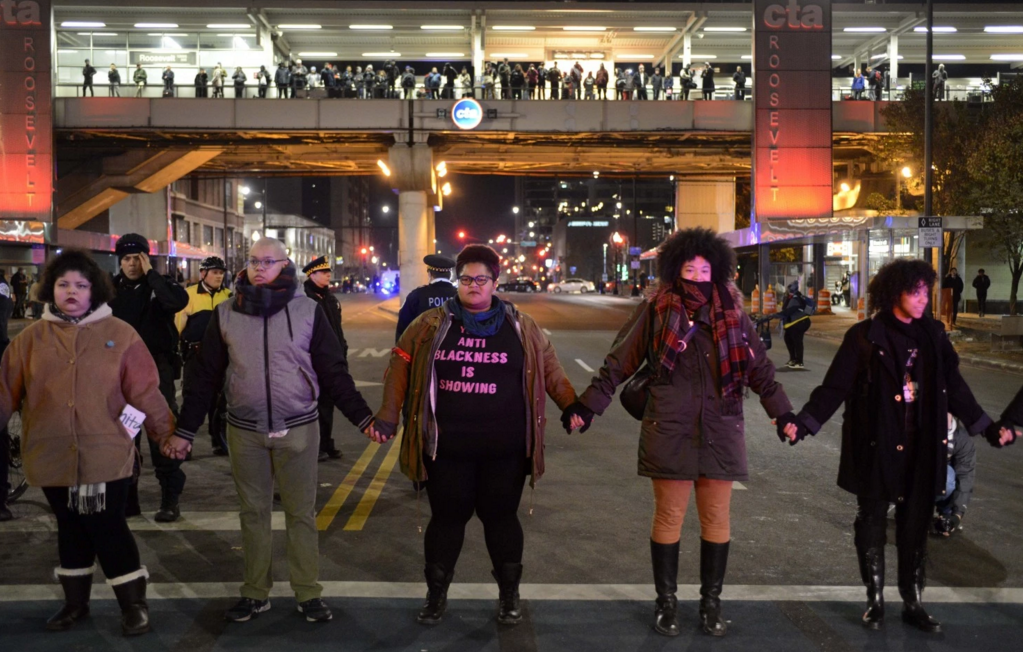Protests In Chicago After Video Reveals Racial "Murder" By Cop
Protesters shut down a street in Chicago

NEW DELHI: Protesters took to the streets of Chicago for a second day following the release of a dashcam video that shows the final moments of 17-year-old Laquan McDonald's life.
The video, released more than a year after the incident took place on October 20, 2014, shows McDonald running, then later walking down the middle of a street, at all times keeping a distance from the police car. He appears to spin around and falls, brought down by a barrage of bullets, as he veered away from the police cars. There were 16 shots fired over 15 seconds, all by Chicago police officer Jason Van Dyke.
Van Dyke was charged with first degree murder a few days earlier, purportedly on the strength of the video evidence against him.
On Wednesday, US President Barack Obama released a statement saying, “Like many Americans, I was deeply disturbed by the footage of the fatal shooting of 17-year-old Laquan McDonald.” “"This Thanksgiving, I ask everybody to keep those who've suffered tragic loss in our thoughts and prayers, and to be thankful for the overwhelming majority of men and women in uniform who protect our communities with honor. And I'm personally grateful to the people of my hometown for keeping protests peaceful," Obama said.
The protests are not solely about McDonald, but the larger issue of racial discrimination and police brutality in America. Laquan McDonald was black, and recent months have seen a huge swell in protests against racial profiling in the American police and criminal justice systems.
In August this year, the city of Ferguson was gripped by protests marking the anniversary of the death of black teenager Michael Brown. Brown, unarmed, was shot in August 2014 by a white police officer who was later cleared of any wrongdoing by a grand jury and the US Department of Justice.
In April this year, thousands took to the streets of Baltimore to protest the death of 25-year-old black man Freddie Gray, who died earlier in the month in police custody. As Ta-Nehisi Coates wrote in The Atlantic, “ Gray did not die mysteriously in some back alley but in the custody of the city's publicly appointed guardians of order. And yet the mayor of that city and the commissioner of that city's police still have no idea what happened.”
Also in April, a video emerged of showing a white US police officer shooting an unarmed black man, Walter Scott -- who tries to run away -- five times in the back. The video led to the officer, Michael Slager, being charged with murder, and contradicted the version of events that had been recorded and admitted where Slager said he feared for his life after his gun was taken away by Scott.
Also recently, protesters took the streets in cities across the US to over the death of Eric Garner, who was killed in an apparent chokehold by a white New York police officer. The protests began after a grand jury decided not to press charges and followed similar protests over a grand jury’s decision to not indict a white police officer who shot to death Michael Brown.
In December 2014, Antonio Martin, an 18 year old black male was shot fatally by a white police officer in a suburb of St. Louis in December 2014.
In November, police in Cleveland, Ohio, shot dead a twelve-year old African-American boy waving around what turned out to be a toy gun at a playground. In October, protesters took to the streets of South St. Louis following the fatal shooting of an African-American man by an off duty police officer.
Other incidents that have grabbed headlines have included 17-year old unarmed Trayvon Martin, who was killed by a neighbourhood watch captain. The shooter was eventually acquitted of murder in a racially charged case.
Other parallels have been drawn as well. The killing of 17-year old Jordan Davis, who was, along with his friends, shot at by a man for playing “loud music.” The jury convicted the shooter on four counts, but not on the count of murder, with many attributing the verdict to a racial context -- the shooter being white and the teenagers, including Davis who died, being black.
These incidents have brought to the surface years of frustration at a system where black men are far more likely to be shot at than their white American counterparts.
The most apparent parallel however, are the Los Angeles riots of 1992 -- where the trigger was the brutal police beating of Rodney King, which was videotaped and widely covered but ended in the acquittal of the officers concerned. These recent protests, much like the LA riots of 1992, may have been a reaction to an immediate trigger, but are located in a far broader context of marginalisation and discrimination.
The incidents located in the larger context have prompted the hashtag, #BlackLivesMatter, with the hashtag resurfacing as protesters took to the streets of Chicago.



